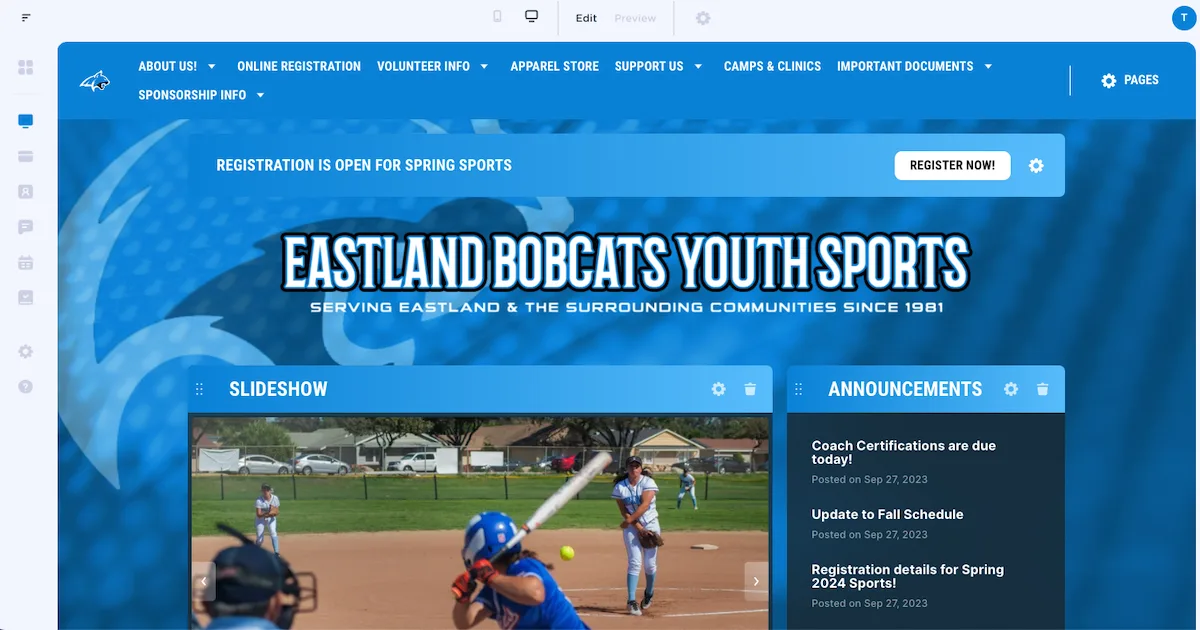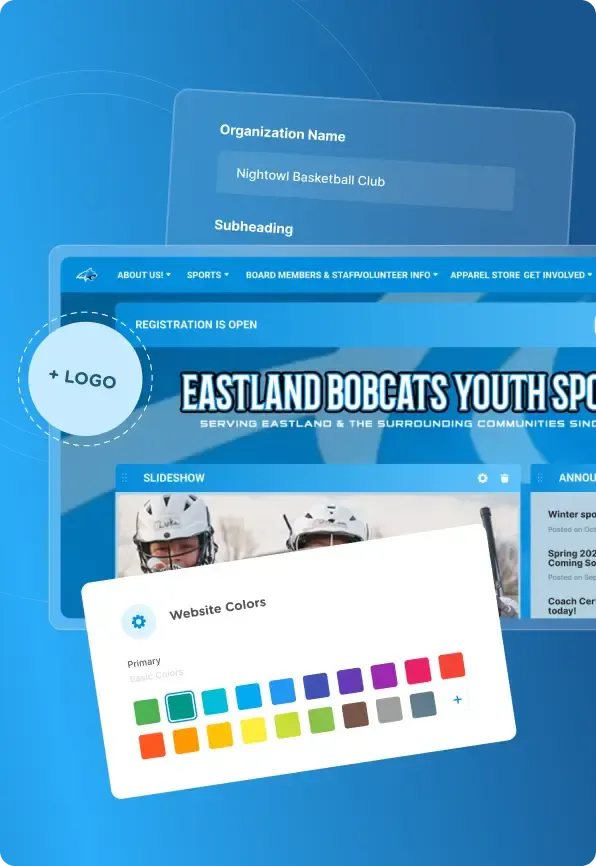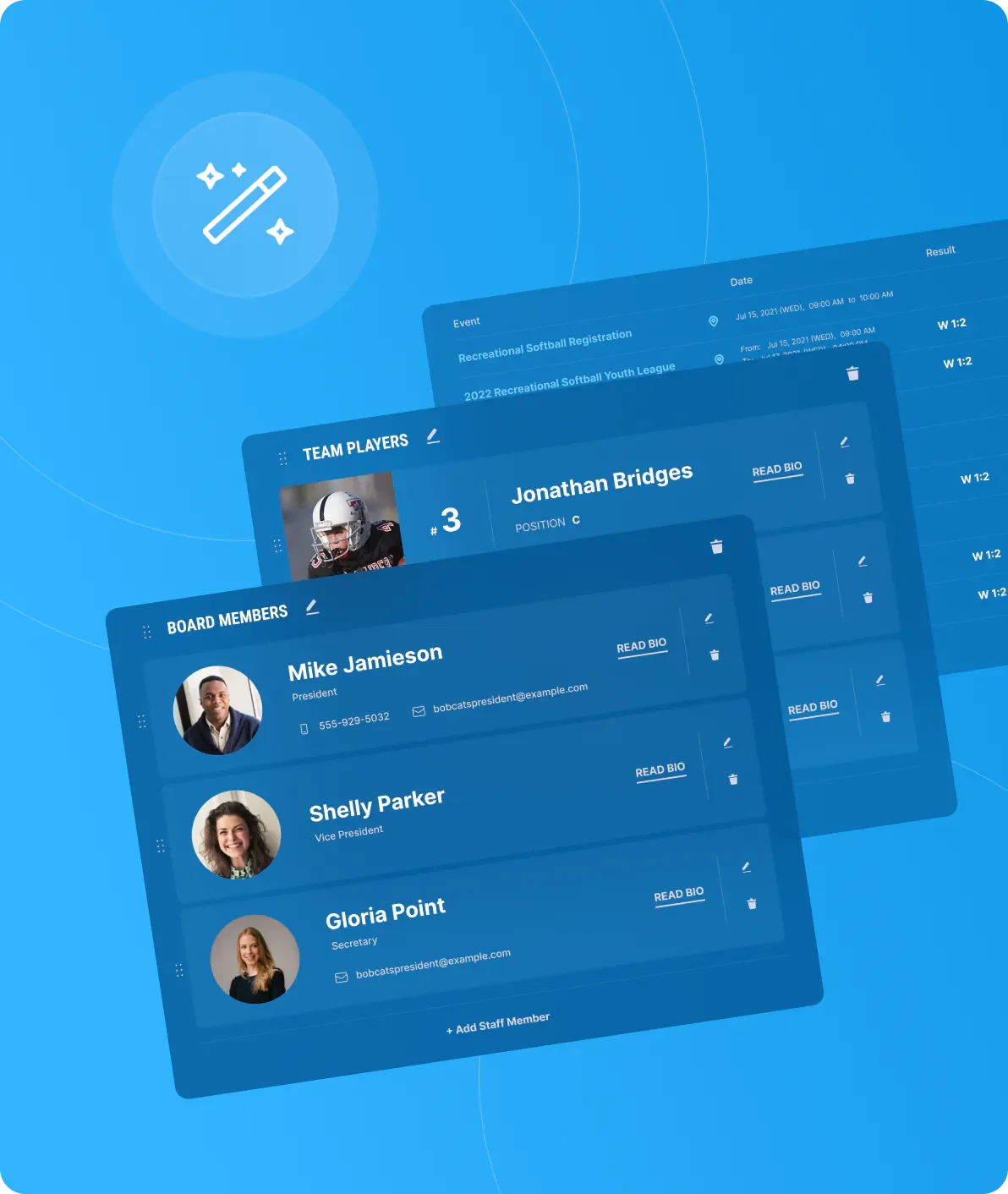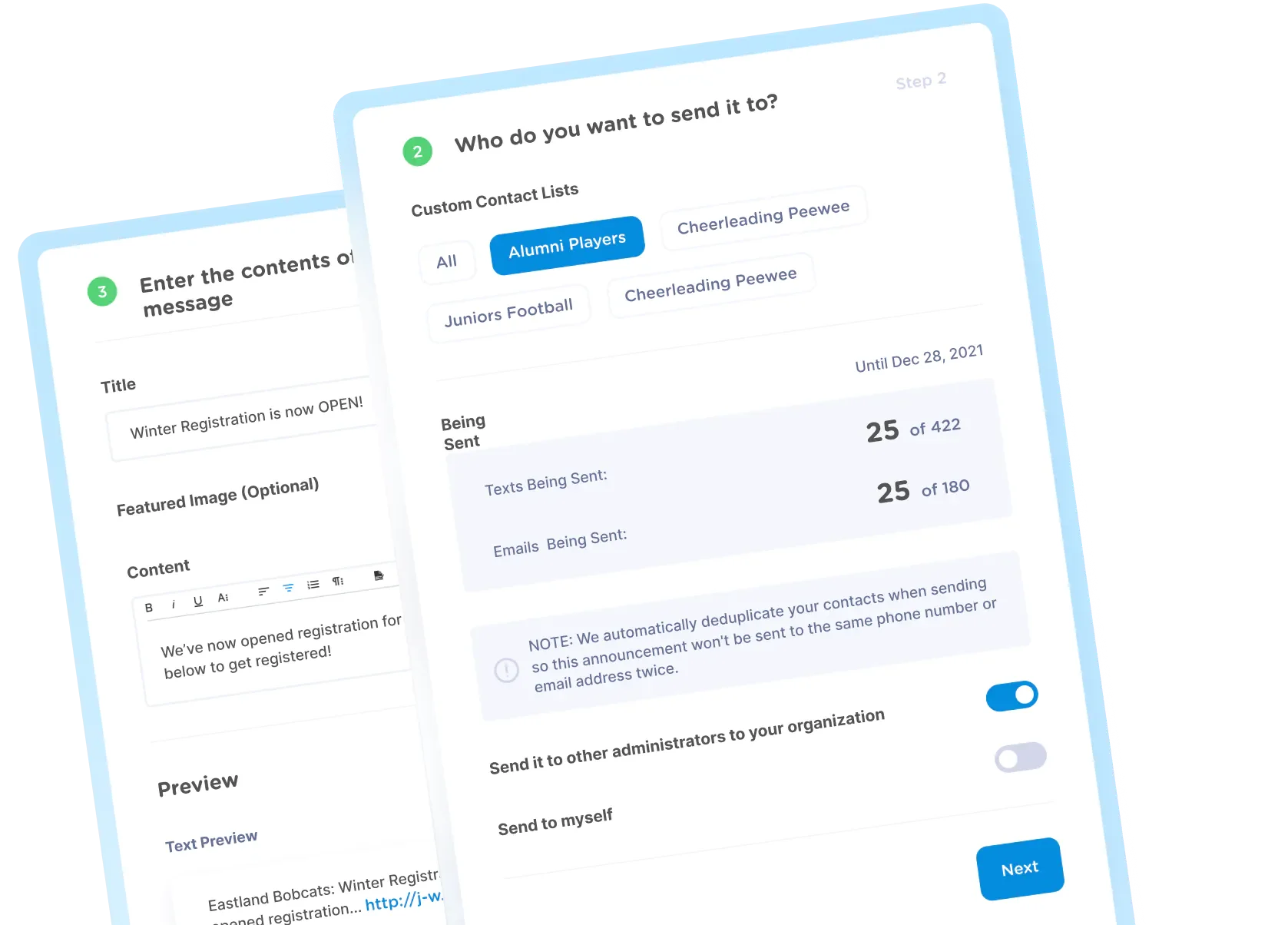
Do you have an outdated league website that you want to improve? Or need to create a sports website for your organization from scratch?
A website can be an effective way for your sports organization to promote your teams, register players, manage payments, and communicate throughout your season.
Follow this step-by-step guide to build a website for your youth sports program next season.
How to create a youth sports website in 5 steps
1. Get organized
Before you start building your website, get some basic information that you can post on your website from Day 1. Here are a few categories that youth sports websites should include:
General organization information
- Logo and other branding
- Contact information for board members and other important volunteers
- Organization overview, like Mission Statement, History, etc.
- Field and Facility locations
- Current sponsors
- Social media accounts
- Game & event schedules
Player registration information
- Dates of registration
- Prices
- Age requirements
- Tryout information, if applicable
- Fundraising requirements
- Waivers, codes of conduct, and any other required acknowledgments
Coach and volunteer information
- Time requirements for volunteers
- How to register as a coach
- Necessary coaching certifications
- Background check policy
2. Customize your website
Next, make sure that your website helps to promote your sports organization. Your website should be used year-round to generate interest and increase participation in your organization.
You can add contact information for your board members, coaches, and staff. You can also include profiles of key people in your organization. This will help to build credibility with parents and other community members.
You should also include your organization’s logo, branding, history, and mission statement. People need to know why your organization exists.

Visitors will also want to experience what it's like to participate in your organization when they land on the website. You should include action photos from games, video recaps from your season, pictures from your banquet or other events, and anything else to help visitors learn more about your season.
3. Choose your domain
Getting a domain name (like www.yoursportsorganization.com) is essential if this is your first time having a website. If you're starting a new sports organization and still need a name, you can brainstorm to come up with a name or get professional help with a memorable name.
Once you’ve named your organization, get a domain name for your website. Domains are generally inexpensive (between $10 and $20 per year), and some website providers include a domain name when you sign up.
You can also transfer domain names between websites. If your organization has an old website, it's generally easy to keep that same domain name if you switch to a new website builder.
4. Optimize your website for search engines
Building more content on your website will also make your site appear in more Google Search Results. You want to ensure that when people search things like "youth sports (insert your community)," your site is easy to find in the search results.
Including more content about your organization, the sport(s) you participate in, and your location is critical to help Google "find" your website when people are searching.
It's also essential to ensure your organization's social media accounts are linked to your new website. This will help Google know that your website exists so it can be listed in searches.
More than 50% of your website’s visitors will be on their phones. So your website must be mobile optimized. Google tests whether websites work well on phones, and will penalize sites that are not mobile-friendly.

📚 Need more tips on getting your website on Google? Learn more here: How to Get Your Sports Organization's Website in Google Results
5. Launch your youth sports website
When you release your website to the public, post an announcement on all of your social media channels. If possible, send a notification via email or text to parents and community members.
On the website launch date, you should have something exciting to announce—like a new fundraising campaign, sports registration for a new season, or an online team store.
After you launch the site, take the initiative to update it regularly. You should post updated information a few times per month at minimum.
Tips for building your youth sports website
1. Make sure your website is easy to use
Get an intuitive and easy to use website builder. Don't take on too much work by creating extra moving parts or by trying to learn a complex system. Your website builder should be an all in one tool and include website hosting, registration features, and scheduling.

Don't let this be you. Find an easy system to build and manage your sports website.
Websites shouldn't require any "techy" skills or require a manual. Many modern website builders just require a computer and an internet connection. If you can send emails or post on Facebook, you can probably manage a simple website.
Many website builders also allow you to make updates on a phone so you don't have to be at a computer to make changes. If you need to cancel games and you're on the go and don't have access to a computer, you'll want to be able to post updates to your website quickly from your phone.
2. Show off your mission statement, history, and staff
It's important when people land on your website that they can easily learn about your organization. You should include information about your staff and coaches so parents or community members know who manages the organization.
Listing staff profiles, organization accomplishments, community involvement, and photo albums from previous seasons is a great way to build trust with people learning about your organization or registering for the first time.

A few things you can include on your Homepage or "About Us" section are:
- The year your organization was founded.
- Your Sports Mission Statement or values.
- The communities you serve and locations of events.
- Other important information like age groups, play seasons, volunteer requirements, and liability waivers.
3. Set up player registration and online payments
Registering players and collecting payments efficiently is one of your most important roles as a volunteer. It's critical that parents and community members can quickly fill out a form and pay on your website.
At least 80% of people prefer to pay with a credit or debit card instead of cash or check, which will only continue to rise as millennial parents begin to register their kids for sports.
Parents prefer to use a card because it’s more secure than writing a check, they can monitor and keep track online, and it’s convenient. As a youth sports league offering online payment and registration can save you dozens of hours of work, trips to the bank, and mounds of paper forms.
Make registration and online payment easy, and you'll see participation increase at your organization next season.

The good news is registering players online, and collecting card and other payment methods has become much easier over the past few years. Online systems also allow you to view, sort, and manage player information easily.
4. Promote sponsors
Finding sponsors and recruiting new volunteers can be the most painful tasks if you manage a league or club. You should be using your website to reduce workload and list all of your sponsor information and volunteer requirements.
Most organizations run on tight budgets, and player registration fees need to cover the costs of equipment, uniforms, facility rentals, and anything else you need for your season.
Posting your sponsors with logos and website links can help encourage more companies to sponsor your teams.
Seeking out new sponsors each year can increase your funding. Traditionally signs at your facility or logos on uniforms have been the most popular way to get sponsors involved in youth sports. Today, you should be taking advantage of your website as a key place to promote your sponsors.
5. Recruit volunteers
How many volunteers does your organization need each year? Between head coaches, board members, concession workers, banquet organizers, facility maintenance, and other roles, you can never have too many volunteers.
The website can be used as a way to educate potential volunteers. You can also link your website to a Signup.com or SignUpGenius account to organize volunteer scheduling and booking.
Volunteer requirements should be clearly listed on the website, including any age requirements, how to register, necessary experience, and whether or not coaches are required to complete a background check.
6. Turn your website into a communication hub
Your website should serve as the hub for registration, refund policies, schedules, and in-season communication. To turn your website into the "hub" for sports team management, connect your social media accounts and send updates via text message to parents, coaches, and community members.
Use text messaging to contact participants
Is your organization using phone trees, social media, or email to get the word out about canceled games, payment deadlines, and other important messages?
Using text messaging to send out bulk messages to parents and coaches will be a much more effective way to reach everyone in your organization quickly. Text message open rates are as high as 98%, while only 20% of emails get opened.
Many text messaging systems can integrate with your website or registration system so that everything can be managed in one place.

The Communication Features on Jersey Watch allow you to send text messages to teams, age groups, or your entire organization with a few clicks.
Connect your social media accounts
Chances are your organization probably already has at least one social media account. If not, creating an account on Facebook, Instagram, or Twitter is a great way to get information out to the public. You can link to your social media accounts from your website so that parents can easily like, follow, and interact with one another.
Facebook, Instagram, and Twitter can be great places for nonprofits to post photos, organize around a specific hashtag, and respond to questions.
Social media should be the "cherry on top," not the main focus of your organization's online presence. Not all parents or community members will be on social media, so it's critical to make sure you have a website with all relevant information as the main hub for your teams online.
Never set up a social media account for your organization before? Learn more below:
Build your youth sports website for next season
Remember, as a volunteer, it's critical to not overcomplicate your role or put too much work on your plate. Keep things simple and focus on making registration, payments, and communication quick and easy before and during your season.
And don't wait until the last minute to get started. Spending some time updating your website and getting it ready to go 6 months before your season starts is a great way to get your year off on the right foot.
Youth sports website FAQ
How do I find a sport for my child?
To find a sport for your child you can search on Google for local organizations in your area. You should also decide what sports are best for your child based on their age and interests. Popular sports include youth baseball, volleyball, football, soccer, and lacrosse.
Community Facebook groups can also be a great way to chat with other local parents about their youth sports experiences and recommendations. Many communities will also offer camps and clinics for new players to try a sport for a few days without committing to a full season.
What is the largest youth sports organization?
There are many national youth sports organizations that help promote youth sports regionally and throughout the world. Some of the largest are:
- Little League Baseball and Softball: Little League was founded in 1939 and organizes leagues and tournaments for children aged 4 to 16. There are over 2 million players participating in Little League programs worldwide.
- American Youth Soccer Organization (AYSO): AYSO was founded in 1964 and registers over 500,000 players in youth soccer clubs each year.
- Pop Warner Little Scholars: Pop Warner was founded in 1929 and supports youth football and cheerleading programs. Players are between the ages of 5 and 16, and over 200,000 participants play in Pop Warner programs in the U.S. each year.
- Boys & Girls Clubs of America: The Boys & Girls Clubs of America offer different activities for youth, including many sports programs. There are over 4,500 clubs throughout the U.S. and sports include swimming, basketball, baseball, and more.
- NFL Flag is the largest youth flag football program in the world. There are over 1,500 teams in the U.S. with over 600,000 total athletes.
How do I create a sports team website?
Creating a website for your sports team should be a pretty quick process. The first thing you should do is find a sports website builder that will allow you to create your website without any website building experience. You'll need to do research into various platforms and their competitors.
Once you decide on a website template you’ll want to make sure you get a domain name. If you don’t already own a domain, some website services will include a domain name when you sign up.
Once you’ve created a website you should plan to update it and add new content at least a few times per month with new information like registration programs, event schedules, player profiles, and game photos. Every couple of years, you can refresh the sports website design to give your site a new look.
What is the fastest growing organized youth sport?
Basketball is the most popular team sport for participants in the US, but other sports have also been growing. Participation rates in soccer and lacrosse have been increasing over the last few decades starting in the 1990s. Rugby has grown in participation rates over the last 10 years with many high school and youth programs starting.
For individual sports, participation in martial arts for both adults and youth have been steadily increasing since 2010.